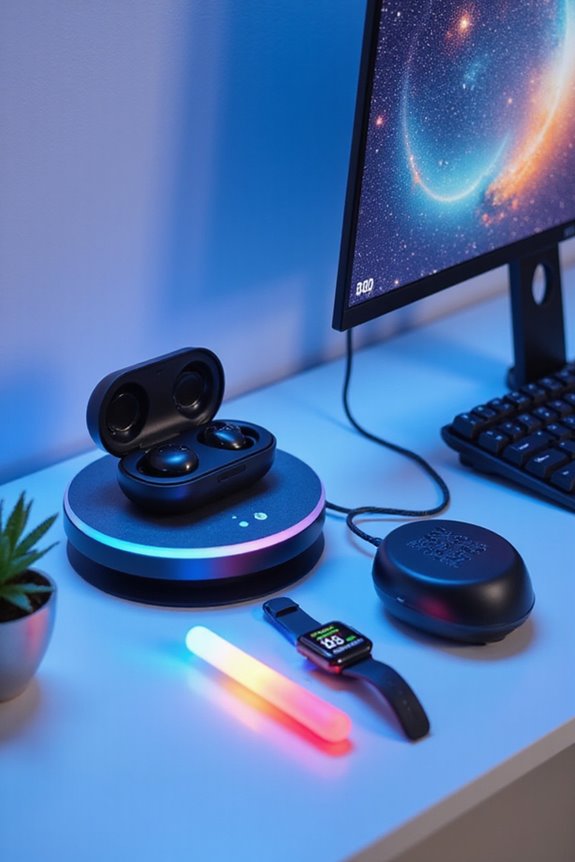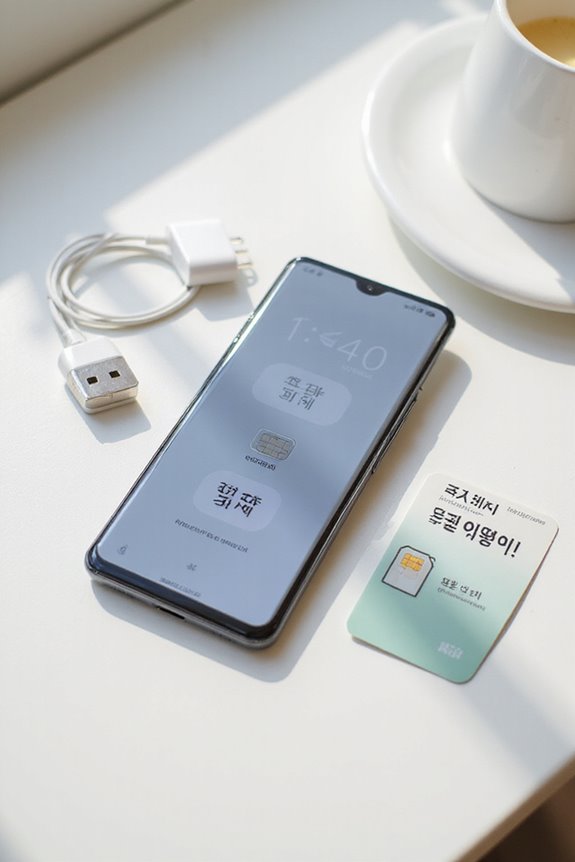When choosing Korean electronics, we should consider market trends and product segments. Major appliances dominate the market, while small appliances are rapidly growing. Innovations like AI and IoT integration are essential, as seen in Samsung’s smart devices. Brand loyalty plays a significant role, with consumers favoring Samsung and LG for their advanced technology. Evaluating features, such as design aesthetics and durability, is critical. By steering through these factors, we can make informed decisions and explore more about this evolving landscape.
Key Takeaways
- Focus on major brands like Samsung and LG, known for their premium products and innovative technology.
- Consider product performance metrics, such as battery capacity and advanced features like AI integration.
- Evaluate the product’s design and style to ensure it aligns with personal preferences and durability.
- Explore e-commerce platforms for convenient comparisons and availability of the latest electronics.
- Stay informed about new market trends and consumer demands, particularly in AI and small appliances.
Understanding Market Trends in Korean Electronics
As we examine the landscape of Korean electronics, we find that market trends are influenced by various factors, including economic conditions and technological advancements. The South Korean consumer electronics market is expected to grow considerably, reaching approximately USD 123.3 billion by 2030. This growth is partly driven by positive economic factors, such as the appreciation of the won against the dollar and higher purchasing power among consumers. Despite challenges like negative demographics, the increasing demand for innovative products, especially in AI and spatial computing, shapes current market dynamics. In addition, advancements in semiconductor technology propel industry developments, enabling products with enhanced performance. Overall, these combined elements create a dynamic environment that influences our purchasing decisions.
Evaluating Key Product Segments

How do we evaluate the key product segments within the Korean electronics market? First, we must consider major appliances, which dominate with a 90.3% revenue share. When analyzing segments, small appliances emerge as the fastest-growing category, projected to expand at a 6.0% CAGR from 2025 to 2030. Consumer electronics, particularly televisions, account for a significant portion of the market, representing 64% of the sector’s value in 2015. To conduct effective product comparisons, we should assess features like smart technology and energy efficiency across various brands. Significantly, e-commerce platforms like Coupang play a substantial role in shifting consumers from traditional retail to online purchasing, thereby impacting purchasing decisions and segment performance. Additionally, understanding key features like battery capacity is vital for consumers when evaluating portable electronics, ensuring they meet their charging needs effectively.
Innovations to Look For

What remarkable innovations can we anticipate in the Korean electronics market? The increasing focus on AI advancements and IoT integration highlights South Korea’s commitment to cutting-edge technology. Companies are investing heavily in AI-powered devices, like smart home appliances, which offer enhanced user experiences through AI integration. For instance, Samsung’s GhostPass, awarded at CES 2025, demonstrates innovative AI-driven authentication solutions. Additionally, efforts to develop intelligent robotics streamline manufacturing processes, improving overall productivity. South Korea also allocates significant funding for self-driving vehicles, advancing automotive technology. As leading chipmakers like Samsung Electronics and SK hynix drive semiconductor innovations, we can expect robust support for AI chip technology, ultimately enhancing device performance and efficiency across various sectors.
Identifying Top Brands and Companies

With a strong emphasis on AI integration and IoT advancements in the Korean electronics market, it’s important to recognize the companies that are driving these innovations. Major Korean brands like Samsung Electronics lead the industry, specializing in a wide range of consumer electronics from smartphones to TVs. LG Electronics is also significant for its home appliances, particularly its award-winning OLED TVs. Additionally, SK hynix plays an essential role in the semiconductor sector, providing memory chips globally. Other key players include LG Display, known for display technology, and MagnaChip, which focuses on OLED display driver chips. By understanding each company’s specialties, we can effectively choose the right products that align with our needs in this competitive market. Notably, LG’s OLED technology has set a high standard for picture quality in televisions.
Assessing Consumer Preferences and Buying Behavior

Understanding consumer preferences and buying behavior in the South Korean electronics market reveals intriguing insights into how individuals make choices in this competitive landscape. South Koreans often prioritize premium products, showcasing a willingness to invest in high-performance electronics with advanced technology integration, such as AI features. Established brands like Samsung and LG command strong consumer loyalty, driven by their solid brand reputation. Consequently, design and innovative features play pivotal roles in shaping buying decisions, particularly for emerging segments like e-readers. Additionally, social media influences purchasing behavior considerably, acting as a platform for brand discovery. This tech-savvy market demands devices that enhance lifestyle convenience, further supporting the growth of electronics that integrate seamlessly into daily routines. Consumers are particularly drawn to stylish designs and durable materials that reflect their personal style while ensuring protection for their devices.
Importance of Technology and Manufacturing Strengths
As we explore the importance of technology and manufacturing strengths in South Korea’s electronics landscape, it’s clear that a strong government framework greatly enhances this sector. South Korea’s substantial investments in research and development promote manufacturing excellence, positioning the country as a global hub for electronics. Initiatives like the “Korean New Deal” focus on digital transformation, facilitating technology integration across industries. The adoption of Industry 4.0 practices, such as AI and IoT, fuels efficiency and innovation within the manufacturing sector. South Korea’s leadership in semiconductor production exemplifies this commitment, accounting for 17.9% of global capacity. This thriving ecosystem not only meets local demand but also strengthens its export economy, underlining the significance of advanced technology in driving industry growth. Furthermore, advancements in audio performance quality contribute to the overall competitive edge of Korean electronics in the global market.
Making Sustainable Choices in Electronics
In today’s rapidly evolving electronics landscape, making sustainable choices is more crucial than ever, particularly for consumers and manufacturers alike. South Korea’s strict environmental regulations guide us toward electronics that utilize sustainable materials and eco-friendly design. For instance, many companies are adopting biodegradable plastics and recycled metals in their products, reducing environmental impact considerably. Additionally, advancements in automation and robotics promote efficient production methods, which not only minimize energy consumption but also enhance product longevity. As we explore our options, considering manufacturers’ commitment to renewable energy, like solar and wind power, becomes essential. Ultimately, these sustainable practices enhance the reputation of South Korean electronics, providing us with choices that are both innovative and environmentally responsible.
Frequently Asked Questions
How Do I Ensure My Electronics Are Compatible With International Standards?
To guarantee our electronics meet international standards for electrical compatibility, we should stay updated on compliance requirements, leverage foreign test reports, and consider professional guidance to navigate regulatory changes effectively. Let’s prioritize quality and safety together!
What Are the Warranty Policies for Korean Electronics Products?
When considering warranty policies for Korean electronics products, we should pay attention to warranty coverage details and register our products promptly. This guarantees we’re fully protected and can efficiently access support if needed.
Are There Specific Retailers Known for Korean Electronics in My Area?
As the saying goes, “Good things come to those who wait.” In our search for Korean retailers, let’s explore local availability to find trusted shops like Lotte Hi-Mart or Coupang for our electronics needs.
How Can I Recycle or Dispose of Old Electronic Devices Responsibly?
When we’re ready to part with old devices, let’s prioritize e-waste management. Using sustainable disposal methods like certified recycling programs, donating, or community collection events guarantees our electronics don’t harm the environment or public health.
What Customer Support Options Are Available for Korean Electronics Brands?
When we think of customer support, we often picture call centers or emails, yet technical support also thrives online. For Korean electronics, we’ve got diverse options, from multilingual helplines to insightful FAQs on official websites.





